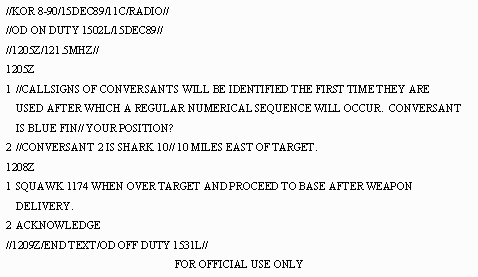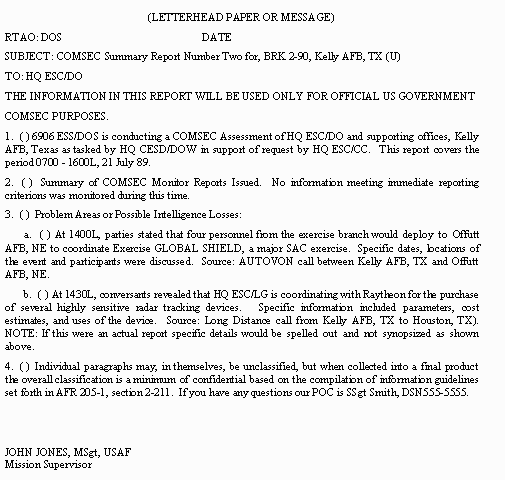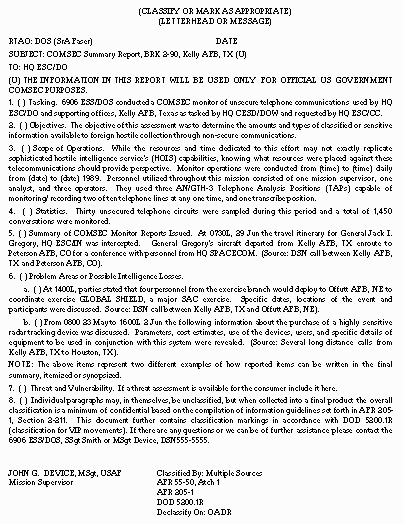The basic purpose of COMSEC monitoring is to provide unique material which is not readily available through other sources, to evaluate the status of U.S. COMSEC. The information collected through COMSEC monitoring is similar to the information potentially available to foreign powers through their own signals intelligence (SIGINT) collection. A COMSEC assessment monitor may be required to support a commander in a direct support role, as part of a MAJCOM or SOA OPSEC survey, COMSEC survey, or in the more traditional role of assisting a commander in identifying COMSEC problems or weaknesses.
Gisting Conversations. Use ESC Forms 128 to prepare a gist of voice communications. A verbatim gist is neither required nor expected; however, a gist must be legible and contain enough detail to enable the analyst or mission supervisor to see the significance of individual conversations. The ESC Form 128 and the corresponding tape will contain the same classification markings or handling instructions.
Transcripts. Transcribe those conversations necessary for analysis, reporting, or continuity. Use the format specified in figures 3-1 and 3-2. A copy of the transcript of any conversation used as a basis for a reportable item will be maintained in the appropriate mission folder.
Releasing Transcripts. To release transcripts, field elements will comply with AFR 56-8 and the following procedures.
Sanitized Format. Prepare sanitized transcripts approved for release outside a unit as follows:
Prepare a cover letter to the organization for which the sanitized transcript is intended or include an introductory paragraph if forwarded electrically. Reference all previous correspondence relating to release of the transcript; also, identify the circuit or frequency, dates and times of the conversation, location or locations involved, mission number, and tasking authority. Include an explanatory paragraph on the procedures to be followed to obtain a complete transcript if the situation warrants further action.
Mark transcripts appropriately and forward them according to AFR
205-1 or AFR 12-30. Include the statement: "Access to this transcript is for evaluation purposes only. The number of personnel provided access should be kept to the absolute minimum necessary for a complete evaluation."
Releasing Unsanitized Transcripts. Any organization, after reviewing a sanitized transcript, may request the names of persons and other identifying data by written certification to HQ ESC/DO that a security violation has occurred. HQ ESC/DO will then direct the COMSEC assessment element to forward the transcript according to AFR 56-8 for release approval. Do not provide unsanitized transcripts without written authorization. Prepare unsanitized transcripts for release as follows:
Send the transcript to HQ ESC/DOOS with a cover letter or include an introductory paragraph if the transcript is to be transmitted electrically. Reference all previous correspondence relating to the project or mission number, dates and times of the conversation, locations involved, and the telephone circuit or radio frequency. Include all information necessary for clarity and explain any items which may not be obvious to the reader.
Mark transcripts with the appropriate, overall classification and include the statement, "Access to this transcript is for evaluation purposes only. The number of personnel provided access should be kept to the absolute minimum necessary for a complete evaluation." Forward according to AFR 205-1 or AFR 12-30.
DOD COMSEC Information. Periodically, COMSEC assessment field elements note COMSEC disclosures involving other DOD components. Report this information (using the appropriate type of report) to HQ ESC/DO for action unless obtained as part of a monitor supporting joint operations. For joint operations, report the information as directed by the project's executive agent. Do not include names of conversants or other identifying data except as specified in governing directives. HQ ESC/DO will send COMSEC reports not obtained as part of joint operations to HQ USAF/SCTT for action. Department of Defense components that need exact transcripts will forward requests through HQ USAF/SCTT to HQ ESC. HQ ESC will provide such transcripts only after removing Air Force personnel identifying data.
Classifying Transcripts. Classify all transcripts (sanitized or unsanitized) according to content. As a minimmum, mark transcripts FOR OFFICIAL USE ONLY (according to AFR 12-30). Transmit hardcopy transcripts by First Class Mail (AFR 82-2) unless prohibited by the classification level.
Safeguard Equipment. To safeguard COMSEC assessment monitoring equipment from unauthorized access, keep equipment not in use in controlled storage.


//OKI 7-90/09JAN90/29A/TELEPHONE//
//PU ON DUTY 0735L/10JAN90//
//1505L/CONV5/LINE2//
1 HELLO, MAY I HELP YOU?
2 IS CAPT .. IN?
1 NO HE WON'T BE BACK UNTIL TOMORRW. //USE OPERATOR COMMENTS
WHENEVER THERE IS DOUBT ABOUT THE INFORMATION TO BE TRANSMITTED AND
WHENEVER IT WILL AID/OR ADD CLARIFICATION FOR THE ANALYST-COMMENT:
HEAVY NOISE ON LINE, MAY HAVE SAID
TONIGHT
VICE
TOMORROW
//
2 THANK YOU.
//1507L/END TEXT/PU OFF DUTY 0737L//
//KOR 8-90/15DEC89/11C/RADIO//
//OD ON DUTY 1502L/15DEC89//
1205Z/121.5MHZ//
1205Z
1 //CALLSIGNS OF CONVERSANTS WILL BE IDENTIFIED THE FIRST TIME THEY ARE
USED AFTER WHICH A REGULAR NUMERICAL SEQUENCE WILL OCCUR.
CONVERSANT IS BLUE FIN// YOUR POSITION?
2 //CONVERSANT 2 IS SHARK 10// 10 MILES EAST OF TARGET.
1208Z
1 SQUAWK 1174 WHEN OVER TARGET AND PROCEED TO BASE AFTER WEAPON
DELIVERY.
2 ACKNOWLEDGE
//1209Z/END TEXT/OD OFF DUTY 1531L//



